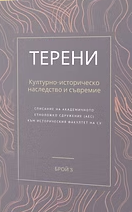Socio-Cultural Model of Development in the City of Radnevo
DOI:
https://doi.org/10.60053/TER.2018.3.71-87Abstract
Founded in the 1750s, The village of Radnevo, depending on its geographical location (in the Upper Thracian land, near the town of Stara Zagora) has provided the livelihood of its inhabitants mainly through agricultural activities. Before and, especially after the Liberation, the village was formed as a large cereal center, developing cereal-trade activities related to cereals throughout the region. This role is further enhanced by the construction of the Simeonovgrad – Radnevo – Nova Zagora railway line in 1872-1873. Trade and production of wheat and others continues to be the main way of subsistence for the inhabitants of the village until the Second World War. The new communist authority in Bulgaria decides to take on the path of heavy industry, and this requires energy. It turns out that the East Marshall Coal Basin is the largest in the country and it is decided to create Maritza-Iztok Mines – energy enterprise. The headquarters of the enterprise is organized in Radnevo village and the new city completely changes its socio-cultural development model.
References:
Koycheva 1970: Koycheva, Velichka. Izvestia na istoricheskoto druzhestvo v Bulgaria. S., kn. 23, 1970
Ovcharova 1946: Ovcharova, Donka. Etnografsko izsledvane na selo Radnevo, okolia Starozagorska. Diplomna rabota, predstavena v katedrata na Slavyanska etnografia pri SU. S., 1946
Downloads
Published
Issue
Section
License
Copyright (c) 2025 Мария Младенова

This work is licensed under a Creative Commons Attribution 4.0 International License.





